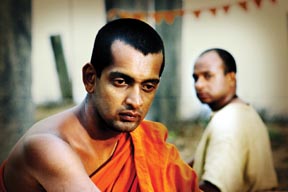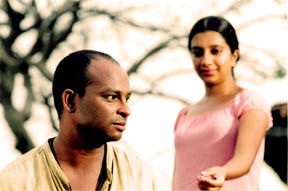|
observer |
|
|
|
|
|
OTHER LINKS |

|

|

|
Exclusive:
|
|
|
 Sankara (Introspection) which won the prestigious Silver Pyramid
award at the recently concluded Cairo International Film Festival is
based on Buddhist parables and explores the range of emotions and moods
that undergo in the mind of a young Buddhist priest who called to
restore paintings in a temple.
Sankara (Introspection) which won the prestigious Silver Pyramid
award at the recently concluded Cairo International Film Festival is
based on Buddhist parables and explores the range of emotions and moods
that undergo in the mind of a young Buddhist priest who called to
restore paintings in a temple.
Sankara is a film by Prasanna Jayakody.
Speaking on the happy moment at the Cairo International Film Festival Prasanna recalled that the Head of the Jury described Sankara as the cinematic poem, read frame by frame, explaining life. One of the major achievements of Sankara is that it won an International Award at the very first film festival it represented.
Prasanna did not believe until his name was called that he would secure an award at the Cairo Film Festival given the stiff competition the film was confronted with. Compared to other films presented at the festival, Sankara had the lowest budget.
Although Sankara is based on a Buddhist parable and set against the Buddhist background and culture, the representatives from diverse countries who took part in the festival, read the theme of the film and experienced it albeit its complex diction and cinematography.
According to Prasanna Jayakody, this was amply manifested by the response he received from a palatine Filmmaker who understood the symbolism in the film and the message of wisdom that it conveys. Sankara has also been nominated for the Kerala Film Festival.
Prasanna believes in the existence of material and spiritual worlds and that he wanted to speak about the spiritual aspect of life. Life can be divided into two; material and spiritual. All that existed materially is similar to dreams.
 For instance a glass is subject to break so is our body and other
materials are also subject to change. However, what is static in our
body is what is not material; mind. What the filmmaker strived in
Sankara is to speak about the human mind and the range of emotions that
it goes through.
For instance a glass is subject to break so is our body and other
materials are also subject to change. However, what is static in our
body is what is not material; mind. What the filmmaker strived in
Sankara is to speak about the human mind and the range of emotions that
it goes through.
The film consisted of three main characters; Ven. Ananda, his thoughts and the paintings and the rest are allegories that represent internal emotional conflict in Ananda's mind. A young Buddhist monk does not represent Buddhism or society of Buddhist monks but in fact, represents a generation who is caught up in an inner conflict.
The film is woven around an inner struggle of a young Buddhist monk who comes to a temple to restore paintings. The paintings depict the Thelapaththa Jathakaya, a moral story where Buddha advises that man with a big target should not be shaken by passion (Keles), the five senses and especially beautiful women.
The film portrays how the young monk's mind gradually gets attracted to sensual pleasures and worldly desires and attachments that he is caught up with. While restoring the painting for the second time after they were destroyed, the monk comes to a realization that he is caught up in a web of desires like those depicted by the paintings.
The young filmmaker drives home the truth that spiritual development is the only way out from these desires which bring about pain and suffering. The Buddhist monk has so many constrains in life as a Bhikku. Apart from the robe that he wears, his thoughts as a young man would not be different from any other youth if he has not attained any spiritual development.
The saffron robe has imposed myriad of blockades. So, he has to suppress his feelings. His mind constantly suffers from worldly desires and is always entangled in a cobweb of desires.
Another character of the film represents the young Bhikku's thoughts and desires. This character moves as far as the young Bhikku's thoughts. Another aspect of this young Bhikku's character is that he is an artist who arrived at a temple to restore and preserve ancient paintings.
Those ancient pictures may have been adored by generations of devotees who visited the temple. The paintings would have been decayed and restored many times. This process would have been continued for centuries.
The paintings depict the Thelapaththa Jathakaya, a moral story where Buddha clearly stated that a man with a definite aim in life must not be swayed by passion (keles), the five senses and especially pretty women.
The young Bhikku's worldly desires and sensual attachments are portrayed through the paintings. Here, the director has used the paintings as an allergy instead of dwelling on the story depicted by the paintings. It is here that the creator shows his mastery in the craft.
While restoring the paintings, the young Bhikku began to develop a strong attachment towards the paintings..
Other characters in the film such as the chief Incumbent and some incidents shed light on the young Bhikku's character.
Towards the end of the work, the young Bhikku realises the futile nature of being attracted to worldly desires.
A temple on a hillock, and a village in the valley with a sugar cane plantation that stretched out into the horizon are potent imageries that symbolise worldly life (samsara). Especially the barren hillock is encircled by the greenery where human activities of samsara continues unabated, and the barren hillock serves as a spiritual icon of the people in the valley of misery. The land mass of the hillock physically differs from the valley of tears.
The film maker has been able to derive the expected objectives from camera and music which blended well into the theme. The director's dominance over every aspect of the film is evident throughout the film which may have been of a greater concern for the jury to select this work of Art for the Silver pyramid award, the best award for creativity in the festival.
Towards the end of the film the convergence of the camera is on the illuminated paintings, while the music at that point achieves a celestial quality to suggest a spectrum beyond the boundaries of the young monk's vision.
Prasanna has been able to retain the attention of the viewers throughout the film, especially the most effective beginning and the inconclusive end. The excellent cinematography is evident from the very frame of the first scene which surpasses the traditional boundary of visual image and merge itself into the very indepth theme and philosophy of the film so much so that even though some may not understand the deep meaning of the film, the visual effects will convey an idea of the theme.
Palitha Perera maintains a steady flow of the camera with even lighting while the Art director created the paintings which plays a significant role in the film. Make up by Priyantha Sirikumara and music by Nadeeka Guruge complements the scene. The two producers, Renuka Balasooriya and Somarathna Dissanayake should be commended for granting the director complete liberty and their contribution for a creation with refined taste.









